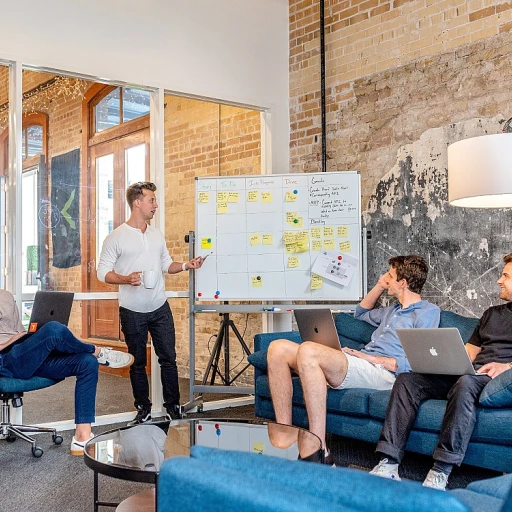Understanding Rapid Improvement Events
Gaining Clarity Over Rapid Improvement Events
Rapid Improvement Events (RIEs), often referred to as kaizen events, are pivotal strategies in the realm of continuous improvement. Unlike traditional methods of transformation, RIEs are designed to expedite the process improvement journey, delivering results in mere days. The structure of these events focuses on evaluating the current state, identifying problems, and implementing changes swiftly with the help of a cross-functional team.
These improvement events seamlessly integrate lean and lean sigma principles, ensuring that success is not just a possibility but an achievable outcome. Implementing standard work practices during these events will help organizations in identifying the precise areas that require enhancement. By focusing on practical, immediate changes, RIEs not only solve existing problems but also set a foundation for daily improvement practices.
A team engaged in an RIE commits to intensely focusing on process improvement, guided by the shared goal of moving the organization from its current state to a more efficient, desired state. The involvement of team members from various functions ensures diverse perspectives are considered, addressing multiple facets of the problem in one go.
To gain a deeper understanding of RIEs and their effectiveness, it is vital to appreciate the methodologies behind it which can be explored through related approaches, such as the iterative and incremental hybrid approach. This approach, much like RIEs, emphasizes adaptability and immediate impact, allowing for swift transformations without compromising on the quality of improvements.
The Role of Leadership in Rapid Improvement
The Importance of Leadership in Navigating Rapid Changes
Leadership plays a pivotal role in the success of any rapid improvement event, especially when it comes to steering the organization towards a more effective and efficient current state. Leaders not only set the vision but also create a supportive environment where team members feel empowered to pursue continuous improvement.
In the fast-paced world of rapid improvement events, leaders must be prepared to adapt and respond to changes quickly. This requires a deep understanding of process improvement techniques such as kaizen, lean, and lean sigma. By fostering a culture of daily improvement, leaders inspire teams to engage in cross-functional problem solving, which is crucial for addressing complex organizational challenges.
Encouraging open communication among team members is essential. This ensures that everyone is aligned with the organization’s goals and understands the significance of the rapid improvement process. When leaders practice active listening, they can more effectively guide the RIE team towards identifying potential improvements and implementing standard work methods that enhance productivity.
Ultimately, success in an improvement event hinges on the capability of leaders to mobilize functional teams and leverage improvement software to capture and analyze data. This data-driven approach provides a clear picture of the current state, which will help in crafting strategic, problem-solving initiatives to achieve swift transformation within just a few days.
As leaders guide their teams through the journey of rapid improvement, they lay the foundation for sustainable changes that contribute to the overall success of the organization.
Strategies for Implementing Rapid Improvement
Crafting a Strategic Path to Rapid Improvement
Implementing strategies for rapid improvement can significantly enhance the success of transformation events within any organization. Understanding how to effectively deploy these techniques begins with assembling a cross-functional team that embodies diverse expertise crucial for addressing multifaceted challenges. This assemblage, often referred to as the RIE team, should include individuals familiar with the current state of processes and those inclined towards problem solving.
In orchestrating a kaizen event, the focus lies in facilitating an environment conducive to continuous improvement. Utilizing methods derived from lean sigma, the functional team works to identify areas within the organization that require attention. By breaking down traditional silos, these team members engage collaboratively in the process of improvement. Standard work is temporarily set aside to explore innovative solutions and foster continuous progress.
Successful rapid improvement can be bolstered by technology. Leveraging improvement software as part of your toolkit will help the team to track and visualize changes during and after the event. This is particularly advantageous in assessing the outcomes of the process improvement endeavors. These tools can provide real-time data, facilitating informed decision-making and enabling the team to swiftly respond to emerging issues.
Incorporating daily improvement activities within the framework of a rapid improvement event is essential. This approach allows the team to remain agile, maintain momentum, and incrementally adjust strategies as needed. By dedicating a few days to concentrated efforts, organizations can experience significant improvements that align with larger strategic objectives.
Emphasizing the role of strong leadership in this process, as discussed earlier, ensures that these strategies are implemented effectively. It is the guidance and visionary outlook of the leadership that solidifies the path to transformation. For more insights into positioning your leadership team to influence these events successfully, consider exploring further resources on how to guide your leadership team on this critical journey.
Overcoming Challenges in Rapid Improvement
Navigating Roadblocks During Rapid Improvement Initiatives
Implementing rapid improvement events can present several challenges that need to be addressed for success. These barriers often arise from the very nature of the swift transformation process, and overcoming them is crucial for achieving lasting change.- Resistance to Change: One of the most common barriers is resistance from team members. It’s essential to cultivate a culture of continuous improvement where all team members understand the benefits of these initiatives. Encouraging open discussions and involving team members in the decision-making process can mitigate resistance.
- Lack of Clear Leadership: Leadership plays a pivotal role in guiding the team through the kaizen event. Strong leadership helps maintain focus on the objectives of the rapid improvement efforts. Leaders should provide clear communication, resources, and reinforce the importance of the changes being made.
- Insufficient Training and Resources: Teams often struggle due to a lack of adequate training or resources. Investment in proper training on lean principles and process improvement methodologies can empower the team to tackle problems effectively. Utilizing improvement software can also streamline the process and support standard work.
- Cross-functional Collaboration: Rapid improvement events require cross-functional collaboration. To achieve this, it’s vital to foster a collaborative environment where different functional teams can work together smoothly. This collaboration will help in addressing complex problem-solving needs.
- Understanding Current State: Without a clear understanding of the current state, improvement efforts might lack direction. Conducting a thorough analysis of the current processes and pinpointing areas that need improvement will help set the stage for successful outcomes.
- Time Constraints: The short duration of rapid improvement events can be a challenge. RIE team members need to focus on quick wins initially, making use of daily improvement goals to gradually move towards larger objectives. Setting realistic and achievable targets within a given timeframe can enhance the likelihood of success.
Measuring Success in Rapid Improvement Events
Evaluating Success Metrics in Rapid Improvement Processes
Implementing rapid improvement events is only part of the journey; measuring their success is equally crucial. It provides insight into the changes made and whether they have achieved the desired effects. Here's how organizations can effectively measure success in these improvement events:- Define Clear Objectives: Clearly defined objectives at the start of any improvement event are essential. These objectives guide the team and serve as benchmarks for measuring success. It's important that these goals are aligned with both the organization's overall vision and the continuous improvement goals.
- Utilizing Lean Methodologies: Metrics drawn from lean practices, such as process time reduction, error reduction, or increased efficiency, can be indicators of success. Improvement efforts should always strive to align with identified lean principles.
- Engagement Metrics: The involvement and engagement levels of the team members during an improvement kaizen event can serve as a qualitative measure of success. High participation often correlates with successful problem-solving outcomes.
- After-Event Reviews: Conducting a thorough review of the current state post-event allows organizations to identify if the changes have been integrated effectively. It also highlights areas that may require further attention.
- Advancements in Actual Metrics: Quantitative metrics, such as cost savings, cycle time reductions, or increased productivity, provide tangible evidence of improvement. Documenting before-and-after states offers a clear view of achievement.
- Continuous Monitoring: Success in rapid improvement is not a one-off event; it involves continuous oversight. This ensures the changes become part of the standard work and evolve with organizational needs.
Case Studies of Successful Rapid Improvement
Real-World Examples of Rapid Improvement Success
To truly grasp the potential of rapid improvement events, it's helpful to look at real-world examples that highlight how these processes can drive successful transformation within organizations. The following case studies demonstrate the power of cross-functional collaboration and the application of kaizen principles to overcome problems and achieve lasting improvements.
In one example, a manufacturing company facing frequent production delays decided to implement a rapid improvement event to address its issues. A cross-functional team, consisting of members from production, quality control, and supply chain logistics, was assembled to tackle the root causes of the delays. Using lean sigma techniques, the team focused on problem-solving to enhance process efficiency. Within a matter of days, the organization achieved significant gains, reducing lead times and increasing overall productivity. The success of this kaizen event was attributed to the team's commitment to understanding the current state of operations and collaboratively working towards continuous improvement.
Another example comes from the healthcare sector, where a hospital utilized an improvement event to streamline its patient admission process. The hospital's leadership realized that delays in admissions were contributing to patient dissatisfaction and resource wastage. By launching an RIE focused on process improvement, the hospital brought together a cross-functional team that included doctors, nurses, and administrative staff. This effort led to the development of a new standard work protocol that minimized waiting times and enhanced patient experiences. The team's ability to rapidly identify and implement changes demonstrated the value of a well-coordinated improvement event.
Finally, a software development company employed continuous improvement techniques to refine their project management practices. Faced with frequent project overruns and budget issues, the company organized a series of kaizen events to evaluate their processes. The iterative approach allowed them to implement targeted adjustments and measure success in real-time. As a result, the company's project delivery improved significantly, fostering a culture of daily improvement among team members.
These case studies illustrate not only the effectiveness of rapid improvement methodologies but also highlight the essential role that leadership and team dynamics play in achieving success. By addressing the challenges head-on and focusing on continuous enhancement, organizations can transition from their current state to one of optimized performance.











